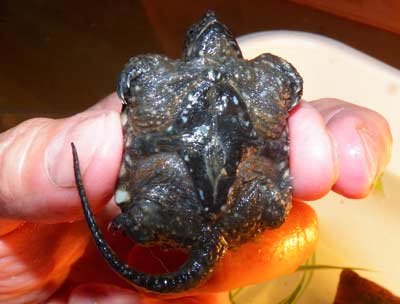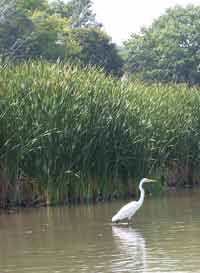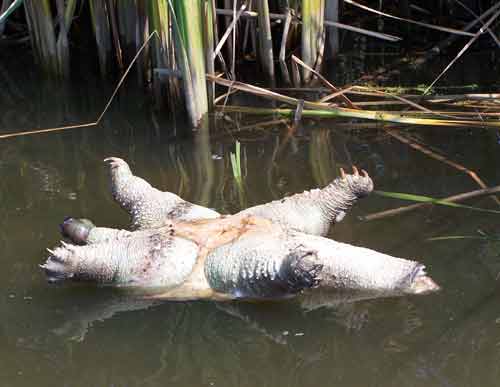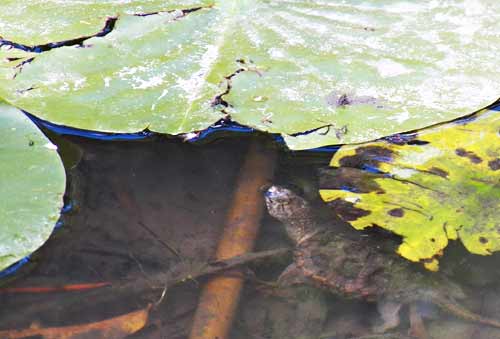
Rescue and Release of Snapping Turtle Hatchling

The Baby Snapper
A few springs ago we had a terrific rain storm and this washed out a whole field of debris from the Humber river. It was about 100 feet outside the breakwall. The band of muddy water and floating branches and small logs was clearly visible from shore.
About a week later I found a tiny snapping turtle being scraped against the docks of my boat club, and rocks of the shore. He was not very lively and there was no beach nearby where he could get out of the water and escape the pounding.
Conditions were very rough and there was no easy place to safely release it. I don't think it is a very good idea to bring wild animals home. They don't usually do very well unless you really know how to care for them and many places have laws against this anyway. There was not much choice in this case.
I took him home and put him in a vat of clean water with a brick to climb on and some greenery. Many turtle that mostly live in the water still need to come out occasionally and can drown if they don't have a shallow enough area.
I tried to feed him various things but he was very weak and unresponsive. At this point I though he had been stressed too much and he was done for and would die.
My purpose was strictly rescue and I had every intention of releasing this turtle as soon as the weather improved and I could get to a proper release site.

Feeding a Snapping Turtle
Snapping turtles are described as omnivorous. Like humans, bears and many other animals, they have a varied diet that includes meat and fish including carrion and fruit and vegetable matter.
I tried my little guy on raw fish, tinned tuna and chicken, slivers of vegetables and fruit, cat food and anything else I could think of including shrimps. Nothing doing he just sat there in the water absolutely apathetic. He was not really even afraid of me. This was not very encouraging.

After a couple of days I tried sowbug and this was an immediate success with my snapping turtle hatchling. My sluggish little turtle perked up and lightning quick snapped up the bugs that were scuttling around on the brick. Sowbugs are also called pill bugs and I think wood lice, and live under rocks and along the foundation of buildings. I had a ready supply living in loose bricks in my paved back garden.
They don't look very appetizing to me but they were ambrosia to the turtle.
He perked up happily after his first meal. Within a day he was happily swimming around, eating any meat, fish or fly I put in and just generally looking good. He was afraid of me and would wait till I went away to eat. He never seemed to eat any vegetable matter. I gave him apples and bananas, sweet pepper, corn, lettuce, cooked asparagus, and greens but he never paid any attention to any of it.
I never tried to tame him because I intended to release him as soon as the weather settled and I next went rowing.
He enjoyed it when his plastic pan would be filled up with clean water after cleaning. I used filtered water in case the chlorine hurt him.
I call him HIM, but Francis the snapping turtle could have been a her. The sex is determined by the incubation temperature of the eggs. I don't know how to sex snapping turtles. I think it is not obvious. I've had yellow sliders and they can easily be differentiated by the shape of the shell and the length of the tail. Not so with snapping turtles.


First photo is snapping turtle when I got him. Second photo is after a month. He has almost doubled in weight. He eats ravenously and will gulp 15 sow bugs in a couple of minutes. If I offer flies after this he will find space for a few of those as well. Hollow tail?
If you look carefully at the plastron when he was smaller will see a soft spot where the egg yolk sack was. The sack itself has been re-absorbed but the opening is quite soft to the touch. On the older photo the opening in the snapping turtle plastron is closed. It is not soft to the touch and is smaller.
Snapping turtles can't retract into their shells like other turtles. They tuck-in as best they can and fight if they have to.
I did not find this snapper aggressive at all. He was shy and if handled would tuck in rather than bite. He never tried to bite. I think its a misconception that snapping turtles are dangerous. I think they will defend themselves if they are threatened but not attack. If someone picked you up by your tail maybe you would bite too!
I had another snapper many years ago and kept it over a winter. He also was a very gentle animal. I had a female yellow slider however who would try to take your finger off anytime you came near.

Releasing my little Snapping Turtle
The Humber River has large areas of swamp with cattails and lily pads and all kinds of birds, turtles and water life.
There are several quiet little bays that are too shallow for power boats to navigate. I chose one of these as a good spot for releasing this Snapping Turtle.
There is no current there so the turtle would not be at risk of being washed out again.
About 2 weeks before the release I had added sand to the turtle pan and moved him to the back yard so he would get used to the sunshine and darker background. He was frightened at first but got used to the outside sunshine and he darkened slightly. I did not expect him to change colours like this. He is covered in algae anyway so blends in very well.
I don't think snapping turtles are very elegant swimmers. My little guy is quite clumsy and spends most of his day in the bottom half buried in the sand. He comes up to eat and breathe but goes back down and sits quietly.

I knew there were snapping turtles in the Humber river because last year when I had rowed up the Humber I had run across a dead snapper. It had no obvious injuries and was quite large.

I chose what looked like a suitable spot to release my little guy. It's quiet and I've seen other turtles around. Boaters don't really go there because there is not enough water. My little boat only draws a few inches. I guess the odd Kayaker will explore there.

There is about 6 inches of water on a muddy bottom and lily pads often have lots of bugs and snails around them. I hope it's a good spot to hide and find stuff to eat. Before releasing him I had fed him till he could eat no more and I think that would last him for a few days.
I put the oar in the water and he stepped off and went to the bottom, he looked around and took in the scenery, then came up for a breath and a look. He then slowly made his way under a leaf. That was the last I saw of him.

Here he has just been released and is coming up for a look around. Shortly after this he headed forward to the lily pads and started his new life.
Snapping turtles don't have any serious predators but raccoons and other creatures will occasionally eat them. They are getting rarer. They don't start reproducing till they are quite old. The mouth of the Humber is protected but he's awfully small!
Email Christine

National Audubon Society Field Guide to Reptiles and Amphibians: North America (National Audubon Society Field Guides (Paperback))

Peterson Field Guide to Reptiles and Amphibians of Eastern and Central North America, Fourth Edition (Peterson Field Guides)

For the serious turtle researcher: Turtles of the United States and Canada

If you decide to keep turtles keep in mind they require UV light either as sunshine or with a lamp. Zoo Med Aquatic Turtle Uvb & Heat Lighting Kit

Zoo Med Combo Pack Turtle Lamp

Penn Plax Turtle Tank Topper - Above-Tank Basking Platform for Turtle Aquariums, 17 x 14 x 10 Inches

If you decide to keep turtles, get a set up that has a filter. It will save you lots of not so pleasant work. Reptile Habitat Setup Aquarium Tank Kit Filter Screen Lid Bask Lamp Turtle Frog & eBook by Easy2Find

Tetra 19524 Decorative Terrarium ReptoFilter, Woodlands
